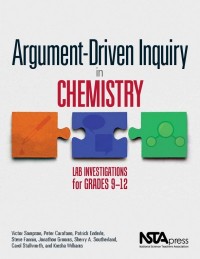Learn to engage students in scientific argumentation
By Claire Reinburg
Posted on 2014-11-14
In his popular workshops at last week’s NSTA conference in Orlando, Victor Sampson presented tips and strategies for engaging students in scientific argumentation, a key practice of science that helps students master content while they write about and discuss claims and evidence. This month’s Book Beat features classroom activities designed to foster students’ ability to analyze data, construct arguments, and learn to support claims with evidence.
Discussion and Argumentation in the Science Classroom
The goals of science education today include helping students not only understand important concepts but also learn to do science. The Next Generation Science Standards emphasize that students need to understand disciplinary core ideas, be aware of seven crosscutting concepts that span the disciplines of science, and learn how to participate in eight key scientific practices to be proficient in science. One increasingly popular way to knit all these elements together is argument-driven inquiry, an innovative approach to lab instruction and the focus of a growing series of books by Victor Sampson and his colleagues. The just-published Argument-Driven Inquiry in Chemistry: Lab Investigations for Grades 9–12 is an engaging approach to lab instruction that brings together content, crosscutting concepts, and scientific practices to make labs more authentic and educative for students.The authors place emphasis throughout the book on argumentation—the process of proposing, supporting, evaluating, and refining claims—which the National Research Council advocates using more in today’s  science classes. Download the free lab “Characteristics of Acids and Bases: How Can the Chemical Properties of an Aqueous Solution Be Used to Identify It as an Acid or a Base?”, which gives students an opportunity to devise, test, and refine a method that can be used to classify an aqueous solution as being an acid or a base using the physical or chemical properties of the solution. Students will also learn about the difference between observations and inferences in science and the different methods used in scientific investigations.
science classes. Download the free lab “Characteristics of Acids and Bases: How Can the Chemical Properties of an Aqueous Solution Be Used to Identify It as an Acid or a Base?”, which gives students an opportunity to devise, test, and refine a method that can be used to classify an aqueous solution as being an acid or a base using the physical or chemical properties of the solution. Students will also learn about the difference between observations and inferences in science and the different methods used in scientific investigations.
The biology-centered books that use this method include Scientific Argumentation in Biology: 30 Classroom Activities, by Victor Sampson and Sharon Schleigh, and  Argument-Driven Inquiry in Biology: Lab Investigations for Grades 9–12, by Victor Sampson et al. Click the book title links above to visit these books’ pages in the Science Store, where you can download sample labs from each of these books. Browse the Fall 2014 NSTA Recommends digital catalog to see the array of books available from NSTA Press across grade levels and science disciplines. Also visit the NGSS@NSTA Hub on the NSTA website for a wealth of additional resources related to NGSS.
Argument-Driven Inquiry in Biology: Lab Investigations for Grades 9–12, by Victor Sampson et al. Click the book title links above to visit these books’ pages in the Science Store, where you can download sample labs from each of these books. Browse the Fall 2014 NSTA Recommends digital catalog to see the array of books available from NSTA Press across grade levels and science disciplines. Also visit the NGSS@NSTA Hub on the NSTA website for a wealth of additional resources related to NGSS.
Disclaimer: The views expressed in this blog post are those of the author(s) and do not necessarily reflect the official position of the National Science Teaching Association (NSTA).



